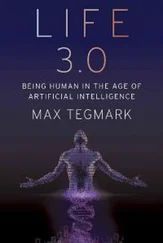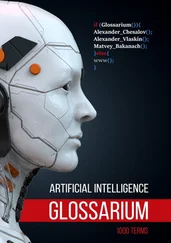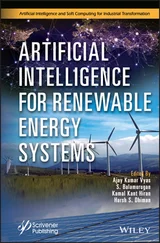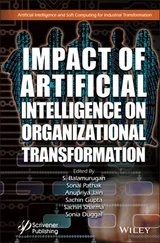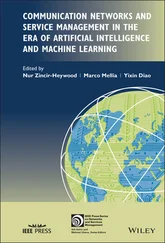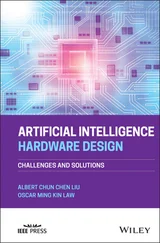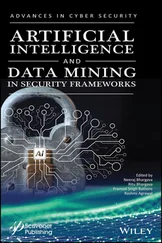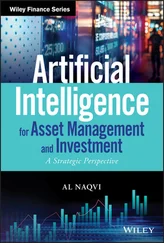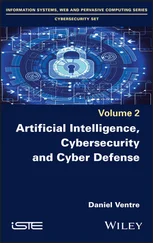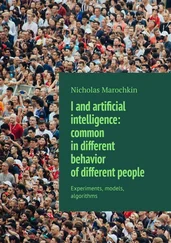Jason L. Anderson - Artificial Intelligence for Business
Здесь есть возможность читать онлайн «Jason L. Anderson - Artificial Intelligence for Business» — ознакомительный отрывок электронной книги совершенно бесплатно, а после прочтения отрывка купить полную версию. В некоторых случаях можно слушать аудио, скачать через торрент в формате fb2 и присутствует краткое содержание. Жанр: unrecognised, на английском языке. Описание произведения, (предисловие) а так же отзывы посетителей доступны на портале библиотеки ЛибКат.
- Название:Artificial Intelligence for Business
- Автор:
- Жанр:
- Год:неизвестен
- ISBN:нет данных
- Рейтинг книги:4 / 5. Голосов: 1
-
Избранное:Добавить в избранное
- Отзывы:
-
Ваша оценка:
- 80
- 1
- 2
- 3
- 4
- 5
Artificial Intelligence for Business: краткое содержание, описание и аннотация
Предлагаем к чтению аннотацию, описание, краткое содержание или предисловие (зависит от того, что написал сам автор книги «Artificial Intelligence for Business»). Если вы не нашли необходимую информацию о книге — напишите в комментариях, мы постараемся отыскать её.
Artificial Intelligence for Business — читать онлайн ознакомительный отрывок
Ниже представлен текст книги, разбитый по страницам. Система сохранения места последней прочитанной страницы, позволяет с удобством читать онлайн бесплатно книгу «Artificial Intelligence for Business», без необходимости каждый раз заново искать на чём Вы остановились. Поставьте закладку, и сможете в любой момент перейти на страницу, на которой закончили чтение.
Интервал:
Закладка:
The modern era has embedded code in everything we use. From your washing machine to your car, if it was made any time in the last decade, there is likely code inside it. In fact, the term “Internet of Things (IoT)” has emerged to define all Internet-connected devices that are not strictly computers. Although the code on these IoT devices is becoming smarter with every upgrade, the devices are not exactly learning autonomously. A programmer has to code every new feature or decision into a model. These programs do not learn from their mistakes. Advancement in AI will help solve this problem, and soon we will have devices that will learn from the input of their human creators, as well as from their own mistakes. Today we are surrounded by code, and in the near future, we will be surrounded by embedded artificially intelligent agents. This will be a massive opportunity for upgrades and will enable more convenience and efficiency.
Although companies may have implemented software projects on their own or with the help of outside vendors in the past, AI projects have their own set of quirks. If those quirks are not managed properly, they may cause a project to be a failure. A brilliant idea must be paired with brilliant execution in order to succeed. Following the path laid out in this book will put you on a trajectory toward managing AI projects more efficiently, as well as prepare you for the age of intelligent systems. Artificial intelligence is very likely to be the next frontier of technology, and in order for us to maximize this opportunity, the groundwork must be laid today.
Every organization is different, and it is important to remember not to try to apply techniques like a straitjacket. Doing so will suffocate your organization. This book is written with a mindset of best practices. Although best practices will work in most cases, it is important to remain attentive and flexible when considering your own organization's transformation. Therefore, you must use your best judgment with each recommendation we make. There is no one-size-fits-all solution, especially not in a field like AI that is constantly evolving.
Ahead of the recent boom in AI technologies, many organizations have already successfully implemented intelligent solutions. Most of these organizations followed an adoption roadmap similar to the one we will describe in this book. It is insightful for us to take a look at a few of these organizations, see what they implemented, and take stock of the benefits they are now realizing. As you read through these organizations' stories, keep in mind that we will be diving into aspects of each approach in more detail during the course of this book.
Case Study #1: FANUC Corporation
Science fiction has told of factories that run entirely by themselves, constantly monitoring and adjusting their input and output for maximum efficiency. Factories that can do just-in-time (JIT) ordering based on sales demand, sensors that predict maintenance requirements, the ability to minimize downtime and repair costs—these are no longer concepts of speculative fiction. With modern sensors and AI software, it has become possible to build these efficient, self-bolstering factories. Out-of-the-box IoT equipment can do better monitoring today than industrial sensors from 10 years ago. This leap in accuracy and connectivity has increased production threshold limits, enabling industrial automation on a scale never before imagined.
FANUC Corporation of Japan, 1 a manufacturer of robots for factories, leads by example. Its own factories have robots building other robots with minimal human intervention. Human workers are able to focus on managerial tasks, whereas robots are built in the dark. This gives a whole new meaning to the industry saying “lights-out operations,” which originally meant servers, not robots with moving parts, running independently in a dark data center. FANUC Japan has invested in Preferred Networks Inc. to gather data from their own robots to make them more reliable and efficient than ever before. Picking parts from a bin with an assortment of different-sized parts mixed together has been a hard problem to solve with traditional coding. With AI, however, FANUC has managed to achieve a consistent 90 percent accuracy in part identification and selection, tested over some 5,000 attempts. The fact that minimal code has gone into allowing these robots to achieve their previously unobtainable objective is yet another testament to the robust capabilities of AI in the industrial setting. FANUC and Preferred Networks have leveraged the continuous stream of data available to them from automated plants, underlining the fact that data collection and analysis is critical to the success of their factory project. FANUC Intelligent Edge Link & Drive (FIELD) is the company's solution for data collection to be later implemented using deep learning models. The AI Bin-Picking product relies on models created via the data collected from the FIELD project. Such data collection procedures form a critical backbone for any industrial process that needs to be automated.
FANUC has also enabled deep learning 2 models for situations where there are too many parameters to be fine-tuned manually. Such models include AI servo-tuning processes that enable high-precision, high-speed machining processes that were not possible until recently. In the near future, your Apple iPhone case will probably be made using a machine similar to the one in Figure 1.1.
Most factories today are capable of utilizing these advancements with minor modifications to their processes. The gains that can be achieved from such changes will be able to exponentially elevate the output of any factory.

FIGURE 1.1 Example of a FANUC Robot3
Case Study #2: H&R Block
H&R Block is a U.S.-based company that specializes in tax preparation services. One of their customer satisfaction guarantees is to find the maximum number of tax deductions for each of their customers. Some deductions are straightforward, such as homeowners being able to deduct the mortgage interest on their primary residence. Other deductions, however, may be dependent on certain client-specific variables, such as the taxpayer's state of residence. Deduction complexity can then be further compounded by requiring multiple client-dependent variables to be considered simultaneously, such as a taxpayer with multiple sources of income who also has multiple personal deductions. The ultimate result is that maximizing deductions for a given customer can be difficult, even for a seasoned tax professional. H&R Block saw an opportunity to leverage AI to help their tax preparers optimize their service. In order to help facilitate the adoption process, H&R Block partnered with IBM to leverage their Watson capabilities. 4
When a customer comes into H&R Block, the tax preparer engages them in a friendly discussion. “Have you experienced any life-changing events in the last year?,” “Have you purchased a home?,” and so on. As they talk, the tax preparer types relevant details of the conversation into their computer system to be used as reference later. If the customer mentions that they purchased a house last year, that will be an indicator that they may qualify for a mortgage interest deduction this year.
H&R Block saw the opportunity here to leverage the use of AI to compile, cross-reference, and analyze all of these notes. Natural language processing (NLP) can be applied to identify the core intent of each note, which then can be fed into the AI system to automatically identify possible deductions. The system then presents the tax professionals with any potentially relevant information to ensure that they do not miss any possible deductions. In the end, both tax professionals and their customers can enjoy an increased sense of confidence that every last applicable deduction was found.
Читать дальшеИнтервал:
Закладка:
Похожие книги на «Artificial Intelligence for Business»
Представляем Вашему вниманию похожие книги на «Artificial Intelligence for Business» списком для выбора. Мы отобрали схожую по названию и смыслу литературу в надежде предоставить читателям больше вариантов отыскать новые, интересные, ещё непрочитанные произведения.
Обсуждение, отзывы о книге «Artificial Intelligence for Business» и просто собственные мнения читателей. Оставьте ваши комментарии, напишите, что Вы думаете о произведении, его смысле или главных героях. Укажите что конкретно понравилось, а что нет, и почему Вы так считаете.

